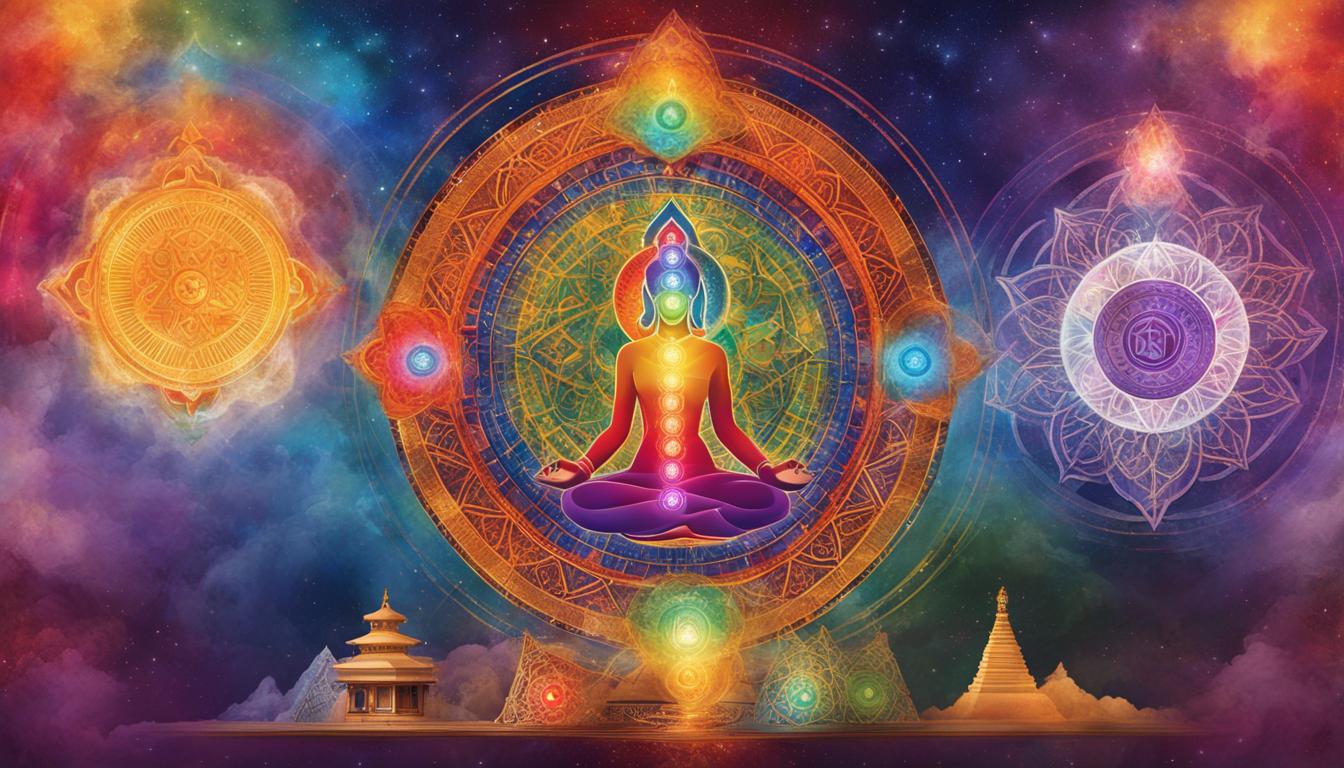Welcome to an exploration of the religious significance of chakras. Chakras, also known as Cakra, hold a special place in certain forms of Hinduism and Tantric Buddhism. These psychic-energy centers are believed to be focal points where psychic forces and bodily functions merge and interact. The importance of chakras in religious traditions can be seen in practices like bindi-wearing to activate the Third-Eye Chakra and access inner wisdom.
Key Takeaways:
- Chakras have significant importance in certain forms of Hinduism and Tantric Buddhism.
- They are conceived as psychic-energy centers where psychic forces and bodily functions merge.
- Chakras are associated with specific colors, shapes, sense organs, natural elements, deities, and mantras.
- Practices like bindi-wearing are used to activate specific chakras and access inner wisdom.
- The religious significance of chakras is evident in various practices and traditions.
The Concept of Chakras in Hinduism and Buddhism
Chakras play a significant role in spiritual practices and belief systems in Hinduism and Buddhism. These energy centers are considered focal points of prana, or life force energy, within the body. While Hinduism recognizes six or seven chakras, Buddhism commonly acknowledges four. These chakras are believed to be interconnected through energy channels called nadi, forming a complex network within the subtle body.
Chakras are not merely physical entities but hold profound spiritual significance. They are believed to be the meeting points of spiritual and physical energies, bridging the gap between the material and immaterial realms. Chakra-based therapies, such as yoga and Ayurveda, aim to balance and activate these energy centers to promote overall well-being.
The concept of chakras has influenced various holistic practices, including meditation, sound healing, and energy work. These practices aim to cleanse and optimize the chakras, enhancing spiritual growth, emotional well-being, and physical health. By harmonizing the chakras, individuals seek to achieve a state of balance and alignment, connecting with their higher selves and achieving a deeper sense of inner peace.
The Role of Meditation in Chakra-Based Practices
Meditation is a key component of chakra-based practices as it allows individuals to cultivate awareness and focus their attention on specific energy centers. Through meditation, practitioners can visualize the chakras, envisioning them as spinning wheels of energy or vibrant flowers unfolding within their bodies. By directing their attention to each chakra, they can stimulate and balance the corresponding energy, promoting a sense of harmony and vitality.
Chakra meditation often involves the use of mantras, which are sacred sounds or vibrations that resonate with each energy center. By chanting or silently repeating these mantras, individuals can help activate and align the chakras, facilitating the flow of prana throughout the body. This practice not only promotes physical health but also enhances spiritual development, fostering a deeper connection with oneself and the divine.
The Seven Major Chakras and Their Significance
In Hindu philosophy, there are seven major chakras, each associated with specific qualities and attributes. These chakras are as follows:
| Chakra | Location | Color | Associated Qualities |
|---|---|---|---|
| Muladhara | Base of the spine | Red | Grounding, stability, survival instincts |
| Svadhisthana | Lower abdomen | Orange | Creativity, sensuality, emotional well-being |
| Manipura | Solar plexus | Yellow | Personal power, self-confidence, willpower |
| Anahata | Heart center | Green | Love, compassion, harmony |
| Vishuddha | Throat | Blue | Communication, self-expression, authenticity |
| Ajna | Third eye | Indigo | Intuition, inner vision, spiritual insight |
| Sahasrara | Crown of the head | Violet or white | Connection to higher consciousness, spiritual awakening |
Each chakra corresponds to different aspects of human experience, including physical, emotional, and spiritual dimensions. By understanding and working with these energy centers, individuals can actively participate in their own healing and personal growth, seeking to align their chakras and unleash their fullest potential.
The Role of Chakras in Health and Well-Being
Chakras play a significant role in various religious traditions, particularly in Hinduism and Buddhism, where they are believed to be energy centers that influence both physical and psychological well-being. Balancing and activating these chakras is considered important for maintaining optimal health. Each chakra is associated with specific physiological and psychological aspects, and imbalances in these energy centers can potentially impact a person’s overall well-being.
While scientific evidence supporting the existence of chakras as spiritual energy centers is lacking, many individuals find benefit in chakra-based therapies. These therapies, such as Ayurvedic medicine, yoga, meditation, and Reiki, aim to promote balanced chakra energy and have been found to have positive effects on relaxation, stress reduction, and overall well-being.
Chakra practitioners often utilize various techniques to address imbalances in specific chakras. For example, if someone is experiencing digestive issues or emotional instability, they may focus on balancing the navel chakra. Chakra-based therapies provide individuals with tools and practices to connect with their inner energies, enhance self-awareness, and promote a sense of harmony and well-being.
The Relationship between Chakras and Religion
Chakras hold a deep religious significance in Hinduism, where they are seen as gateways to spiritual enlightenment and higher consciousness. The importance of chakras in Hindu religious traditions is evident in rituals and practices designed to activate and balance these energy centers. Similarly, in Buddhism, chakras are considered important focal points of energy and are often incorporated into meditative and mindfulness practices.
| Religion | Religious Significance of Chakra |
|---|---|
| Hinduism | Chakras play a vital role in spiritual growth and are associated with specific deities, colors, and mantras. |
| Buddhism | Chakras are seen as energy centers through which one can achieve higher states of consciousness and spiritual awakening. |
“The chakras serve to connect the physical body with the subtle body, which includes the mind, emotions, and spirit.”
While chakras are deeply rooted in religious traditions, it is important to note that chakra-based therapies can be practiced by individuals from various religious or spiritual backgrounds. These therapies are not limited to one particular belief system and can be customized to suit an individual’s personal preferences and needs.
The Seven Major Chakras in Hindu Philosophy
In Hindu philosophy, there are seven major chakras that hold significant spiritual and cultural importance. These chakras are believed to be energy centers within the body that correspond to various physical, emotional, and spiritual aspects of our being. Each chakra is associated with specific qualities and functions, and understanding them can provide valuable insights into the Hindu belief system and religious traditions.
The Seven Major Chakras
The following table provides an overview of the seven major chakras, their associated qualities, and their significance in Hindu philosophy:
| Chakra | Location | Associated Qualities | Significance |
|---|---|---|---|
| Muladhara (Root Chakra) | Base of the spine | Stability, grounding | Represents our connection to the physical world |
| Svadhisthana (Sacral Chakra) | Lower abdomen | Creativity, sexuality | Governs our emotional and sexual energies |
| Manipura (Navel Chakra) | Solar plexus | Willpower, confidence | Regulates our personal power and self-esteem |
| Anahata (Heart Chakra) | Center of the chest | Love, compassion | Represents our ability to give and receive love |
| Vishuddha (Throat Chakra) | Throat | Communication, expression | Governs our ability to speak our truth |
| Ajna (Third Eye Chakra) | Between the eyebrows | Intuition, insight | Associated with our inner wisdom and spiritual perception |
| Sahasrara (Crown Chakra) | Top of the head | Connection to the divine | Represents our spiritual connection and higher consciousness |
These chakras, when balanced and activated, are believed to contribute to overall well-being and spiritual growth. Hindu practitioners often engage in various practices such as meditation, yoga, and visualization to cleanse, balance, and activate these energy centers. By doing so, they aim to achieve harmony within themselves and establish a deeper connection to the divine.
Scientific Perspectives on Chakras
From a scientific perspective, there is ongoing debate and limited conclusive evidence regarding the existence of chakras as spiritual energy centers. Some researchers propose that chakras may correspond to physical body parts, particularly within the nervous system. For example, the chakras aligning with the nerve plexuses may facilitate communication between different areas of the body.
However, it is important to note that this interpretation is not universally accepted among the scientific community. Further scientific research is needed to fully understand the relationship between chakras and the physical body. Without concrete evidence, the spiritual significance of chakras remains a matter of belief and personal experience.
“Chakras are fascinating concepts that have profound implications in certain religious traditions. While science has not yet provided definitive answers about their existence, their impact on holistic well-being cannot be denied.”
Regardless of scientific perspectives, chakra-based therapies have gained popularity and are often incorporated into spiritual practices such as yoga, meditation, and Reiki. These practices aim to balance and activate the energy centers in the body for overall well-being.
| Chakra | Associated Body Parts | Associated Functions |
|---|---|---|
| Muladhara (Root Chakra) | Spine, Legs, Feet | Survival instincts, grounding |
| Svadhisthana (Sacral Chakra) | Reproductive organs, Lower abdomen | Creativity, sexuality, emotions |
| Manipura (Navel Chakra) | Stomach, Digestive system | Personal power, confidence |
| Anahata (Heart Chakra) | Heart, Chest, Lungs | Love, compassion, emotional healing |
| Vishuddha (Throat Chakra) | Throat, Neck, Mouth | Communication, self-expression |
| Ajna (Third Eye Chakra) | Forehead, Pineal gland | Intuition, inner wisdom |
| Sahasrara (Crown Chakra) | Top of the head | Spiritual connection, consciousness |
Benefits of Chakra-Based Therapies
Chakra-based therapies, such as meditation and yoga, offer numerous benefits for your overall well-being. These practices have been found to reduce stress, anxiety, and depression, allowing you to experience a greater sense of calm and inner peace.
One of the key advantages of chakra-based therapies is their ability to lower blood pressure. By practicing techniques that balance and activate your chakras, you can promote a healthy flow of energy throughout your body, which in turn can have a positive impact on your cardiovascular health.
Chakra-based meditation programs have also been associated with generalized reductions in anxiety and improvements in perceived health. Engaging in these practices can help you cultivate a greater self-awareness and a deeper connection with your spiritual self, leading to a heightened sense of well-being.
| Benefits of Chakra-Based Therapies | |
|---|---|
| Reduces stress, anxiety, and depression | Improved overall well-being |
| Lowers blood pressure | Enhanced cardiovascular health |
| Reductions in anxiety and perceived health | Increased self-awareness and spiritual connection |
While the exact mechanisms behind these benefits are not fully understood, chakra-based therapies offer a holistic approach to healing and self-care. It is important to note that these therapies should not be viewed as a substitute for medical treatment but can complement it for a more comprehensive approach to your health and well-being.
The History and Evolution of Chakra Concepts
The concept of chakras has a rich history that can be traced back to the ancient Indian texts known as the Vedas. These texts form the foundation of Hinduism and contain valuable insights into the spiritual practices and beliefs of the time. Over the centuries, the understanding and interpretation of chakras have evolved, leading to their widespread adoption in various Hindu and Buddhist traditions.
In the early 20th century, the concept of chakras started gaining attention in the Western world, thanks to the publications of European spiritualists and occultists. These influential figures brought chakras to a broader audience and contributed to the Western understanding of these energy centers.
The Western chakra system expanded upon the traditional Hindu and Buddhist concepts, associating each chakra with different colors, metals, astrological signs, and other correspondences. This new interpretation resonated with many individuals, leading to the incorporation of chakras into various New Age alternative health practices.
The Evolution of Chakras: A Timeline
| Time Period | Development |
|---|---|
| Ancient Times | Chakras are mentioned in ancient Indian texts, such as the Vedas, as psychic-energy centers. |
| 1st – 8th Century CE | Chakra concepts become more prevalent in Hindu and Buddhist traditions, influencing spiritual practices and philosophies. |
| 20th Century | European spiritualists and occultists introduce chakras to the Western world through their writings. |
| Modern Era | Chakras gain popularity in New Age and alternative health practices, incorporating various correspondences and associations. |
“The concept of chakras has evolved over time, adapting to different cultures and belief systems. Today, chakras are widely recognized and embraced as energy centers that play a role in our spiritual and holistic well-being.”
As chakras continue to be explored and studied, their historical and cultural significance provides a fascinating backdrop to their modern-day understanding and application. Whether you approach chakras from a traditional Hindu or Buddhist perspective or through the lens of Western interpretations, the concept of chakras invites us to explore the interconnectedness of our physical, emotional, and spiritual beings.
Conclusion
As you have learned, chakras hold great significance in certain religious traditions, particularly in Hinduism and Tantric Buddhism. These psychic-energy centers are believed to be focal points where spiritual and bodily forces merge. While the existence of chakras as spiritual energy centers lacks scientific evidence, their importance in religious practices cannot be denied.
Chakra-based therapies, rooted in ancient beliefs and practices, have shown positive effects on overall well-being. Practices such as yoga, meditation, and Ayurveda offer individuals a sense of relaxation, spiritual connection, and inner balance. These therapies should be approached with an open mind and used as a complement to medical care, rather than a replacement.
It is fascinating to see how the concept of chakras has evolved over time, from ancient Indian texts to the Western understanding influenced by spiritualists and occultists. Today, chakras are associated with various New Age alternative health practices, expanding their reach beyond religious traditions. They continue to spark curiosity and offer individuals a path to explore their inner selves.
Are Chakra Wands and Chakras Related in Terms of Spiritual Practices?
Chakra wands and chakras are intricately connected in terms of spiritual practices. A crystal chakra wand: spiritual tool explained, it is designed to balance, activate, and heal specific energy centers within the body known as chakras. By using a crystal chakra wand, individuals can enhance their meditation, energy work, and overall spiritual well-being, facilitating a harmonious flow of energy throughout the chakra system.
Are Chakras Related to Specific Religions, such as Cancer?
The chakra and its association with cancer is a topic that often sparks curiosity. While chakras are spiritual energy centers, they are not inherently tied to specific religions or diseases. Chakras are commonly mentioned in Eastern philosophies and healing traditions, focusing on balancing energy for overall well-being. Although there is no direct link between chakras and cancer, many believe that maintaining chakra balance can contribute to overall health and complement conventional medical treatments.
FAQ
What is the significance of chakras in certain religious traditions?
Chakras hold significant importance in certain forms of Hinduism and Tantric Buddhism. They are conceived as psychic-energy centers where spiritual energies intersect and interact.
How many major chakras are there?
There are seven major chakras in Hindu philosophy: Muladhara, Svadhisthana, Manipura, Anahata, Vishuddha, Ajna, and Sahasrara.
What are chakra-based therapies used for?
Chakra-based therapies like yoga and meditation are used to promote balanced chakra energy, which is believed to have positive effects on relaxation, stress reduction, and overall well-being.
Are there scientific studies supporting the existence of chakras?
From a scientific perspective, there is no conclusive evidence supporting the existence of chakras as spiritual energy centers. However, practices like meditation and yoga, rooted in chakra philosophy, have been found to have numerous health benefits.
How can chakra-based therapies benefit individuals?
Chakra-based therapies, such as meditation and yoga, have been found to reduce stress, anxiety, and depression, lower blood pressure, and improve overall well-being. They can promote relaxation, a sense of well-being, and spiritual connection.
What is the history of chakra concepts?
The concept of chakras can be traced back to ancient Indian texts called the Vedas. Over time, the understanding and interpretation of chakras evolved, influencing various Hindu and Buddhist traditions.
Can chakra-based therapies replace medical treatment?
No, chakra-based therapies should not be viewed as a substitute for medical treatment. They can complement traditional medical care for holistic well-being.








